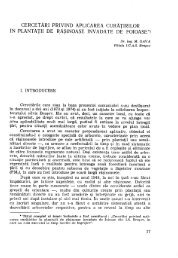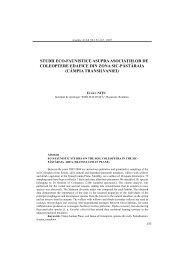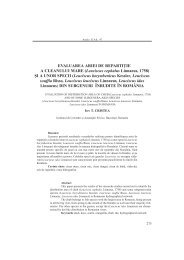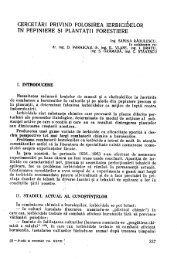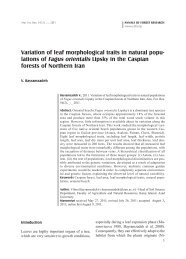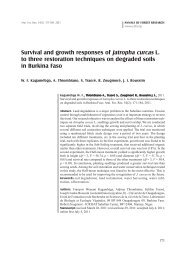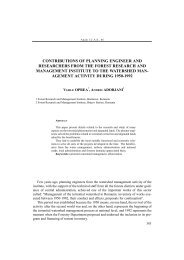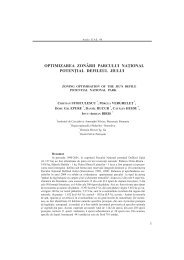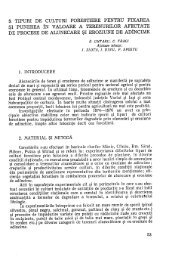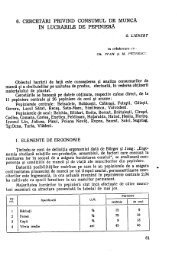Romania (Quercus cerris, Q. frainetto, Q. robur) and - EdituraSilvica.ro
Romania (Quercus cerris, Q. frainetto, Q. robur) and - EdituraSilvica.ro
Romania (Quercus cerris, Q. frainetto, Q. robur) and - EdituraSilvica.ro
You also want an ePaper? Increase the reach of your titles
YUMPU automatically turns print PDFs into web optimized ePapers that Google loves.
Ann. For. Res. 54(1): 57-71, 2011Research articlesTable 2 (continuation)Formofthe apex,diameter(mm)Rhizomorphs<st<strong>ro</strong>ng>and</st<strong>ro</strong>ng> emergenthyphaeTexture of therhizomorphs<st<strong>ro</strong>ng>and</st<strong>ro</strong>ng> emergenthyphae62Mantle,color,textureDistancebetweenconsecutivebranches(mm)Round0.3-0.4Emerginghyphae,right anglessmoothLength ofmycorrizalsystem(mm)Code Host Location Color BranchingSmooth with sulfuryellow granulations2 0.2Round0.4-0.6Round toclavate0.3Round orrelativelyacute0.2-0.4B<strong>ro</strong>wn-blackrhizomorphsreticulated<st<strong>ro</strong>ng>and</st<strong>ro</strong>ng> smoothSympodial,pinnate, sinuousapexesSulfur yellowMihai Bravu08.1997<st<strong>ro</strong>ng>Quercus</st<strong>ro</strong>ng><st<strong>ro</strong>ng>cerris</st<strong>ro</strong>ng> +RussulavirescensM18Monopodial 3 0.1-0.3 velvetynone noneBlack-purplish tojet blackDobreti07.1998M19 <st<strong>ro</strong>ng>Quercus</st<strong>ro</strong>ng><st<strong>ro</strong>ng>cerris</st<strong>ro</strong>ng>Rough withoutconspicuous hyphae11 0.5-1Sympodial, basalconstrictionWhite,shinning,smoothsmoothRusty-black with apinkish tingeTinca09.1998M20 <st<strong>ro</strong>ng>Quercus</st<strong>ro</strong>ng><st<strong>ro</strong>ng>frainetto</st<strong>ro</strong>ng>Velvety, shinningwhite, relatively rare0.2-0.3or lessYellow. Orange Coralloid 6Dobreti07. 1998Buteni06.2000Round0.3-0.4none none<st<strong>ro</strong>ng>Quercus</st<strong>ro</strong>ng><st<strong>ro</strong>ng>cerris</st<strong>ro</strong>ng>,Querus<st<strong>ro</strong>ng><strong>ro</strong>bur</st<strong>ro</strong>ng>M21Smooth withgranular areas19-29 1.2-2Monopodial,pinnate, loose,sinuous branchesPale yellowwith rusty spots<st<strong>ro</strong>ng>and</st<strong>ro</strong>ng> granulationdissolving in KOH10%Giurgiu,Mihai Bravu08. 1997Roundsomewith rustyspots0.3-0.4Ramiedrhizomorphs,interconnectedhairy surface<st<strong>ro</strong>ng>Quercus</st<strong>ro</strong>ng><st<strong>ro</strong>ng>cerris</st<strong>ro</strong>ng> +Russulaat<strong>ro</strong>purpureaM22Wooly, abundant,dense1-4 0.4Monopodial,pinnate, looseyellowGiurgiu,Mihai Bravu08. 1997Round0.3-0.6Orangerhizomorphssmooth <st<strong>ro</strong>ng>and</st<strong>ro</strong>ng>branched<st<strong>ro</strong>ng>Quercus</st<strong>ro</strong>ng><st<strong>ro</strong>ng>frainetto</st<strong>ro</strong>ng>+Xe<strong>ro</strong>comuschrysente<strong>ro</strong>nM23Smooth, rareemerging hyphae(also laticife<strong>ro</strong>ushyphae)5 0.5-0.8Coralloid orpinnateOrange to b<strong>ro</strong>wnwith whitelaticife<strong>ro</strong>us hyphaeBrganu08.1997Round0.2-0.3Rareemergenthyphaesmooth<st<strong>ro</strong>ng>Quercus</st<strong>ro</strong>ng><st<strong>ro</strong>ng>cerris</st<strong>ro</strong>ng>+LactariusquietusM24White-yellowishwith silvery areas,wooly1.5-2.2 0.5Monopodial,pinnate, sinuousapexesBlackish b<strong>ro</strong>wnwith white tingeBrganu08.1997<st<strong>ro</strong>ng>Quercus</st<strong>ro</strong>ng><st<strong>ro</strong>ng>cerris</st<strong>ro</strong>ng> +Scle<strong>ro</strong>dermacitrinumM25
Fodor et al. Mycorrhizal status of several <st<strong>ro</strong>ng>Quercus</st<strong>ro</strong>ng> species in <st<strong>ro</strong>ng>Romania</st<strong>ro</strong>ng> ...Table 2 (continuation)Code Host Location Color BranchingM26 <st<strong>ro</strong>ng>Quercus</st<strong>ro</strong>ng><st<strong>ro</strong>ng>frainetto</st<strong>ro</strong>ng>M27M28<st<strong>ro</strong>ng>Quercus</st<strong>ro</strong>ng><st<strong>ro</strong>ng>cerris</st<strong>ro</strong>ng>,<st<strong>ro</strong>ng>Quercus</st<strong>ro</strong>ng><st<strong>ro</strong>ng><strong>ro</strong>bur</st<strong>ro</strong>ng><st<strong>ro</strong>ng>Quercus</st<strong>ro</strong>ng><st<strong>ro</strong>ng>cerris</st<strong>ro</strong>ng> +Amanitamairei,<st<strong>ro</strong>ng>Quercus</st<strong>ro</strong>ng><st<strong>ro</strong>ng><strong>ro</strong>bur</st<strong>ro</strong>ng>M29 <st<strong>ro</strong>ng>Quercus</st<strong>ro</strong>ng><st<strong>ro</strong>ng><strong>ro</strong>bur</st<strong>ro</strong>ng>Radna10.1998Radna10.1998,Oradea2000Dobreti07.1998Buteni06.2000Oradea06.2000Buteni06. 2000,Oradea06.2000Yellow-dull b<strong>ro</strong>wnWhite-yellowish,near hyalineYellow-orangeWhite-yellowishwith rusty areasRepeatedlymonopodial,pyramidal aspect,bent apexesMonopodial tocoralloid, dense,sometimessolitary, basalconstrictionDichotomous tocoralloidPinnatepyramidalM 30All species +CenococcumgeophilumAll locationsJet black withscle<strong>ro</strong>tiaUnbranched orMonopodialpinnateLength ofmycorrizalsystem(mm)Distancebetweenconsecutivebranches(mm)Mantle,color,texture0.7-1 0.2-0.4 farinaceous0.8-1 0.3-1 Wooly, dense4-8 0.1-1Velvety, rare,shinning white4-6 0.2-0.4Granular <st<strong>ro</strong>ng>and</st<strong>ro</strong>ng> spikydue to cystidsyellowish1-2.5Stringy <st<strong>ro</strong>ng>and</st<strong>ro</strong>ng> shinydue to emergingblack hyphae, grainyFormofthe apex,diameter(mm)Round0.3-0.4Round0.3-0.4Round,slightlybent0.2-0.3Round,hyaline0.3-0.4Round,in olderparts,blackRhizomorphs<st<strong>ro</strong>ng>and</st<strong>ro</strong>ng> emergenthyphaeSmooth,ramiedrhizomorphsFan shapedrhizomorphsRarerhizomorphsemergingat rightanglesBundlesof shortemerginghyphaeBlack, rigidemanatinghyphaeScle<strong>ro</strong>tiapresent: black,spherical,grainy,2 mm,hard <st<strong>ro</strong>ng>and</st<strong>ro</strong>ng>brittle,coated withsoil particlesTextureof therhizomorphs<st<strong>ro</strong>ng>and</st<strong>ro</strong>ng> emergenthyphaesmoothhairysmoothsmoothsmooth63
Ann. For. Res. 54(1): 57-71, 2011wetter <st<strong>ro</strong>ng>and</st<strong>ro</strong>ng> milder during the winter. In South,climate is temperate continental, with p<strong>ro</strong>nouncedtemperature extremes <st<strong>ro</strong>ng>and</st<strong>ro</strong>ng> p<strong>ro</strong>longedd<strong>ro</strong>ught during the summer months. Southernforest st<st<strong>ro</strong>ng>and</st<strong>ro</strong>ng>s are located in plains, frequentlyexposed to summer d<strong>ro</strong>ught (Giurgiu - MihaiBravu, Brneti, Vlsia - Buriau, ExperimentalStation tefneti, Brgan, Vldiceasca,Slveti, Snagov, Comana). Comana <st<strong>ro</strong>ng>and</st<strong>ro</strong>ng> MihaiBravu are located an the Neajlov riverdelta. The st<st<strong>ro</strong>ng>and</st<strong>ro</strong>ng> age varied between 60 <st<strong>ro</strong>ng>and</st<strong>ro</strong>ng> 90years.Stressful conditions affecting the trees f<strong>ro</strong>mdifferent investigated locations were assignedto g<strong>ro</strong>ups: (i) soil pollution f<strong>ro</strong>m an oil extractionplant (Tinca), (ii) several years of recurringd<strong>ro</strong>ught (Brgan), (iii) multiple sourcesof city pollution in the city of Oradea, (iv)ch<strong>ro</strong>nic foliar disease p<strong>ro</strong>duced by ErysipheResearch articlesalphitoides (Griffon & Maubl.) U.Braun &S.Takam <st<strong>ro</strong>ng>and</st<strong>ro</strong>ng> infestations p<strong>ro</strong>duced by gall insects-Dryomyiacircinans (Giraud) (Dobreti)<st<strong>ro</strong>ng>and</st<strong>ro</strong>ng> Cynips quercus-folii (Linnaeus) (Oradea),(v) defoliations p<strong>ro</strong>duced mainly by Lymantriadispar (Linnaeus) (Tinca).Root p<strong>ro</strong>cessing p<strong>ro</strong>tocol. Mycorrhizalsystem is dened as a lateral ramication <st<strong>ro</strong>ng>and</st<strong>ro</strong>ng>all its tributary apices f<strong>ro</strong>m a sustaining suberi-ed <strong>ro</strong>ot, total length varying between 1 <st<strong>ro</strong>ng>and</st<strong>ro</strong>ng> 5cm. During the research mycorrhizal <strong>ro</strong>ot systemswere studied according to this denition,pieces of 10-20 mm being cut <st<strong>ro</strong>ng>and</st<strong>ro</strong>ng> investigatedfor alive <st<strong>ro</strong>ng>and</st<strong>ro</strong>ng> declining mycorrhizal apices.Blocks of soil of 5 x 5 x 5 cm were excavatedin the rhizosphere of selected tree hostspecies (<st<strong>ro</strong>ng>Quercus</st<strong>ro</strong>ng> spp.), in the area of horizontalc<strong>ro</strong>wn p<strong>ro</strong>jection, three trees of the samespecies per st<st<strong>ro</strong>ng>and</st<strong>ro</strong>ng>. The blocks were wrapped1614121086420qcaqcbqcbaqcdqcmbqcoqcsNumber of morphotypesqcslqctqcvqcvlqfaqfdqfgqfmbqfslqftFigure 1 Number of mycorrhizal morphotypes by host (<st<strong>ro</strong>ng>Quercus</st<strong>ro</strong>ng> <st<strong>ro</strong>ng>cerris</st<strong>ro</strong>ng>, Q. <st<strong>ro</strong>ng>frainetto</st<strong>ro</strong>ng>, Q. <st<strong>ro</strong>ng><strong>ro</strong>bur</st<strong>ro</strong>ng>) <st<strong>ro</strong>ng>and</st<strong>ro</strong>ng> locationNotation: qca - <st<strong>ro</strong>ng>Quercus</st<strong>ro</strong>ng> <st<strong>ro</strong>ng>cerris</st<strong>ro</strong>ng>, Arad; qcbr - <st<strong>ro</strong>ng>Quercus</st<strong>ro</strong>ng> <st<strong>ro</strong>ng>cerris</st<strong>ro</strong>ng>, Brgan; qcba - <st<strong>ro</strong>ng>Quercus</st<strong>ro</strong>ng> <st<strong>ro</strong>ng>cerris</st<strong>ro</strong>ng>, Bneasa; qcd- <st<strong>ro</strong>ng>Quercus</st<strong>ro</strong>ng> <st<strong>ro</strong>ng>cerris</st<strong>ro</strong>ng>, Dobreti; qcmb - <st<strong>ro</strong>ng>Quercus</st<strong>ro</strong>ng> <st<strong>ro</strong>ng>cerris</st<strong>ro</strong>ng>, Mihai Bravu, qco - <st<strong>ro</strong>ng>Quercus</st<strong>ro</strong>ng> <st<strong>ro</strong>ng>cerris</st<strong>ro</strong>ng>, F.D. Oradea, qcsl -64Host species<st<strong>ro</strong>ng>Quercus</st<strong>ro</strong>ng> <st<strong>ro</strong>ng>cerris</st<strong>ro</strong>ng>, Slveti; qcs - <st<strong>ro</strong>ng>Quercus</st<strong>ro</strong>ng> <st<strong>ro</strong>ng>cerris</st<strong>ro</strong>ng>, tefneti; qct - <st<strong>ro</strong>ng>Quercus</st<strong>ro</strong>ng> <st<strong>ro</strong>ng>cerris</st<strong>ro</strong>ng>, Tinca; qcv - <st<strong>ro</strong>ng>Quercus</st<strong>ro</strong>ng> <st<strong>ro</strong>ng>cerris</st<strong>ro</strong>ng>,Vldiceasca; qcvl - <st<strong>ro</strong>ng>Quercus</st<strong>ro</strong>ng> <st<strong>ro</strong>ng>cerris</st<strong>ro</strong>ng>, Vlsia; qfa - <st<strong>ro</strong>ng>Quercus</st<strong>ro</strong>ng> <st<strong>ro</strong>ng>frainetto</st<strong>ro</strong>ng>, Arad (Radna); qfd- <st<strong>ro</strong>ng>Quercus</st<strong>ro</strong>ng> <st<strong>ro</strong>ng>frainetto</st<strong>ro</strong>ng>,Dobreti; qfg - <st<strong>ro</strong>ng>Quercus</st<strong>ro</strong>ng> <st<strong>ro</strong>ng>frainetto</st<strong>ro</strong>ng>, F.D. Giurgiu (Comana); qfmb - <st<strong>ro</strong>ng>Quercus</st<strong>ro</strong>ng> <st<strong>ro</strong>ng>frainetto</st<strong>ro</strong>ng>, Mihai Bravu; qfsl -<st<strong>ro</strong>ng>Quercus</st<strong>ro</strong>ng> <st<strong>ro</strong>ng>frainetto</st<strong>ro</strong>ng>, Slveti; qft - <st<strong>ro</strong>ng>Quercus</st<strong>ro</strong>ng> <st<strong>ro</strong>ng>frainetto</st<strong>ro</strong>ng>, Tinca; qrb - <st<strong>ro</strong>ng>Quercus</st<strong>ro</strong>ng> <st<strong>ro</strong>ng><strong>ro</strong>bur</st<strong>ro</strong>ng>, Buteni; q<strong>ro</strong> - <st<strong>ro</strong>ng>Quercus</st<strong>ro</strong>ng> <st<strong>ro</strong>ng><strong>ro</strong>bur</st<strong>ro</strong>ng>,city of Oradea; qcb - <st<strong>ro</strong>ng>Quercus</st<strong>ro</strong>ng> <st<strong>ro</strong>ng>cerris</st<strong>ro</strong>ng>, Buteni.
Fodor et al. Mycorrhizal status of several <st<strong>ro</strong>ng>Quercus</st<strong>ro</strong>ng> species in <st<strong>ro</strong>ng>Romania</st<strong>ro</strong>ng> ...Table 3 P<strong>ro</strong>portion of mycorrhizal apices in <strong>ro</strong>ot samples (15 mycorrhizal systems selected at r<st<strong>ro</strong>ng>and</st<strong>ro</strong>ng>om) collected during the vegetation season f<strong>ro</strong>m several <st<strong>ro</strong>ng>Quercus</st<strong>ro</strong>ng> species, different locations (1996-2001)Tree species, location <st<strong>ro</strong>ng>and</st<strong>ro</strong>ng> date P<strong>ro</strong>portion of mycorrhizal apices (%)Q. <st<strong>ro</strong>ng>cerris</st<strong>ro</strong>ng>, tefneti (08.1996) 43.5Q. <st<strong>ro</strong>ng>cerris</st<strong>ro</strong>ng>, Mihai Bravu (10.1996) 42.0Q. <st<strong>ro</strong>ng>cerris</st<strong>ro</strong>ng>, Brganu (10.1996) 85.0Q. <st<strong>ro</strong>ng>frainetto</st<strong>ro</strong>ng>, Comana (10.1996) 86.0Q. <st<strong>ro</strong>ng>cerris</st<strong>ro</strong>ng>, Tinca (10.1997) 20.0Q. <st<strong>ro</strong>ng>frainetto</st<strong>ro</strong>ng>, Radna (10.1998) 30.0Q. <st<strong>ro</strong>ng>frainetto</st<strong>ro</strong>ng>, Tinca (09.1998) 32.4Q. <st<strong>ro</strong>ng>cerris</st<strong>ro</strong>ng>, Tinca (09.1998) 31.4Q. <st<strong>ro</strong>ng>frainetto</st<strong>ro</strong>ng>, Mihai Bravu (10.1996) 46.0Q. <st<strong>ro</strong>ng>cerris</st<strong>ro</strong>ng>, Dobreti (07.1998) 46.3Q. <st<strong>ro</strong>ng>frainetto</st<strong>ro</strong>ng>, Dobreti (09.1998) 13.1Q. <st<strong>ro</strong>ng>cerris</st<strong>ro</strong>ng>, Dobreti (07.1998) 67.6Q. <st<strong>ro</strong>ng>cerris</st<strong>ro</strong>ng>, Oradea (09.1998) 67.6Q. <st<strong>ro</strong>ng><strong>ro</strong>bur</st<strong>ro</strong>ng>, Buteni (07.2000) 78.0Q. <st<strong>ro</strong>ng><strong>ro</strong>bur</st<strong>ro</strong>ng>, city of Oradea (06. 2001) 33.0in paper <st<strong>ro</strong>ng>and</st<strong>ro</strong>ng> b<strong>ro</strong>ught to the laboratory. Thesamples, corresponding to one tree mergedin one composite sample subjected to furtherp<strong>ro</strong>cessing. Roots were carefully washed intap water using sieves, placed in Petri dishesof 9 cm <st<strong>ro</strong>ng>and</st<strong>ro</strong>ng> observed under stereomic<strong>ro</strong>scopecleaning meanwhile the adhered soil with nebrushes <st<strong>ro</strong>ng>and</st<strong>ro</strong>ng> needles. The descriptions of themorphotypes are based on mac<strong>ro</strong>scopic charactersfollowing the adapted p<strong>ro</strong>tocol afterAgerer (1987-2002). Actual mycorrhizas wereconrmed mic<strong>ro</strong>scopically by the existence ofthe Hartig net <st<strong>ro</strong>ng>and</st<strong>ro</strong>ng> mycorrhizal mantle (Nylundet al., 1982).Quantitative analysis. Comparison ofthe mycorrhizal status (relative frequencies ofactive mycorrhizal apices) in 5 <strong>ro</strong>ot samplestaken f<strong>ro</strong>m <st<strong>ro</strong>ng>Quercus</st<strong>ro</strong>ng> <st<strong>ro</strong>ng>cerris</st<strong>ro</strong>ng> at Dobreti wasperformed by means of One-Way ANOVA. Aprevious test of variance homogeneity (Bartlett)conrmed the lack of signicant differenceswith respect to the variances amongsamples. Also Tukey test of pair-wise multiplecomparisons was performed in order to detectany signicant differences in mycorrhizationfrequency in the 5 samples set collected f<strong>ro</strong>m<st<strong>ro</strong>ng>Quercus</st<strong>ro</strong>ng> <st<strong>ro</strong>ng>cerris</st<strong>ro</strong>ng> <strong>ro</strong>ots at Dobreti. This locationwas selected to perform the specied statisticalanalyses due to the fact that it corresponds tothe highest diversity of morphotypes found atany location, at a particular moment.The association status of different morphotypeswith Coenococcum geophilum Fr., mostfrequently encountered morphotype, was assessedusing Yule coefcient of association.Yule’s Q coefcient of association is a symmetricmeasure, based on the difference betweenconcordant (meaning both absences a,<st<strong>ro</strong>ng>and</st<strong>ro</strong>ng> both presences, d) <st<strong>ro</strong>ng>and</st<strong>ro</strong>ng> discordant (meaningabsence-presence data, b <st<strong>ro</strong>ng>and</st<strong>ro</strong>ng> presence-absencedata, c) data pairs (Singh, 2004).Q = (ad-bc)/(cd+bc)The coefcient takes values between -1 <st<strong>ro</strong>ng>and</st<strong>ro</strong>ng>1: -1 corresponds to a complete exclusion ofthe species, 0 corresponds to r<st<strong>ro</strong>ng>and</st<strong>ro</strong>ng>om associations<st<strong>ro</strong>ng>and</st<strong>ro</strong>ng> 1 to constant associations. Q statisticdenes null relationship as statistical independence.Hierarchical cluster analysis of tree species<st<strong>ro</strong>ng>and</st<strong>ro</strong>ng> locations, with regard to mycorrhizal morphotypes,was performed after the calculationof the Sørensen similarity index. The similar-65
Ann. For. Res. 54(1): 57-71, 201166m30m29m28m27m26m25m24m23m22m21m20m19m18m17m16m15m14m13m12m11m10m9m8m7m6m5m4m3m2m10 10 20Figure 2 Frequencies of mycorrhizal morphotypesin <strong>ro</strong>ot samples of Quecus <st<strong>ro</strong>ng>cerris</st<strong>ro</strong>ng>,<st<strong>ro</strong>ng>Quercus</st<strong>ro</strong>ng> <st<strong>ro</strong>ng>frainetto</st<strong>ro</strong>ng> <st<strong>ro</strong>ng>and</st<strong>ro</strong>ng> <st<strong>ro</strong>ng>Quercus</st<strong>ro</strong>ng> <st<strong>ro</strong>ng><strong>ro</strong>bur</st<strong>ro</strong>ng>in several locations in Southern <st<strong>ro</strong>ng>and</st<strong>ro</strong>ng>North-Western <st<strong>ro</strong>ng>Romania</st<strong>ro</strong>ng>Research articlesity-dissimilarity matrix was used for clusteringby means of g<strong>ro</strong>up average method. Statisticaltests were performed using KyPlot p<strong>ro</strong>gram.ResultsThere were identied 30 morphotypes of ectomycorrhizae,corresponding to <st<strong>ro</strong>ng>Quercus</st<strong>ro</strong>ng> <st<strong>ro</strong>ng><strong>ro</strong>bur</st<strong>ro</strong>ng>,<st<strong>ro</strong>ng>Quercus</st<strong>ro</strong>ng> <st<strong>ro</strong>ng>cerris</st<strong>ro</strong>ng> <st<strong>ro</strong>ng>and</st<strong>ro</strong>ng> <st<strong>ro</strong>ng>Quercus</st<strong>ro</strong>ng> <st<strong>ro</strong>ng>frainetto</st<strong>ro</strong>ng> in Southern,Western <st<strong>ro</strong>ng>and</st<strong>ro</strong>ng> North-Western locations,presented in Table 1. The original descriptions(with the exception of Cenoccocum geophilumdescribed by Agerer in 1987), are presented inTable 2.The investigation of the maximum numbe<strong>ro</strong>f morphotypes active a certain moment in therhizosphere of the host is 14 (Fig. 1) which isthe real instantaneous value of morphotyperichness (Q. <st<strong>ro</strong>ng>cerris</st<strong>ro</strong>ng> at Dobreti).The described morphotypes include only 6cases of identied mycobionts (Amanita maireiFoley, Scle<strong>ro</strong>derma citrinum Pers., Russulaat<strong>ro</strong>purpurea (K<strong>ro</strong>mbh.) Britzelm, Lactariusquietus (Fr.) Fr., Russula virescens (Schaeff.)Fr., Boletus chrysente<strong>ro</strong>n Bull.) based on mycelialcontinuity between mycorrhizal mantle<st<strong>ro</strong>ng>and</st<strong>ro</strong>ng> the mycelium at the base of the carpophores.Easily recognizable Cenoccocumgeophilum Fr. is also included in morphotypedescriptions. Mantles of mycorrhizas with speciesof Lactarius as mycobionts (as examinedon c<strong>ro</strong>ss sections of ne <strong>ro</strong>ots) exhibit characteristiclaticifers <st<strong>ro</strong>ng>and</st<strong>ro</strong>ng> pigments which are alsofound in the structure of the spo<strong>ro</strong>carps. Thoseof Rusulla spp. exhibit distinctive cystidia <st<strong>ro</strong>ng>and</st<strong>ro</strong>ng>sulfovaniline reactive cells (Kernaghan <st<strong>ro</strong>ng>and</st<strong>ro</strong>ng>Currah 1997).The analysis of frequency distribution of thevarious morphotypes (Fig. 2) shows that thedominating type is Cenococcum geophilum(M30) that is present in all locations. Nextmost frequent morphotype is M2 described inQ. <st<strong>ro</strong>ng><strong>ro</strong>bur</st<strong>ro</strong>ng> <st<strong>ro</strong>ng>and</st<strong>ro</strong>ng> Q. <st<strong>ro</strong>ng>cerris</st<strong>ro</strong>ng> at Buteni, Oradea <st<strong>ro</strong>ng>and</st<strong>ro</strong>ng>Slveti but found in almost all locations lessfrequently than C.geophilum.
Fodor et al. Mycorrhizal status of several <st<strong>ro</strong>ng>Quercus</st<strong>ro</strong>ng> species in <st<strong>ro</strong>ng>Romania</st<strong>ro</strong>ng> ...Table 4 The Yule coefcient of association of Cenococcum geophilum with several other mycorrhizal morphotypes in <st<strong>ro</strong>ng>Quercus</st<strong>ro</strong>ng> <st<strong>ro</strong>ng>cerris</st<strong>ro</strong>ng>, DobretiAssociationYule coefcient of associationC. geophilum + M10 -0.8004C. geophilum + M17 -0.1287C. geophilum + M8 0.2564C. geophilum + M3 0.2467C. geophilum + M11 -0.0943C. geophilum associates either r<st<strong>ro</strong>ng>and</st<strong>ro</strong>ng>omlywith other morphotypes in the same mycorrhizalsystem (values close to 0), or excludesother morphotypes (value close to -1 in the associationwith M10) according to our results, apattern consistent with its dominating position.It is also the most frequent <st<strong>ro</strong>ng>and</st<strong>ro</strong>ng> b<strong>ro</strong>ad spectrumhost associated mycorrhizal type as other authorsreport (Moser et al. 2005).The comparison of the mycorrhizal status(relative frequencies of active mycorrhizal apices)among 5 samples of <strong>ro</strong>ots f<strong>ro</strong>m <st<strong>ro</strong>ng>Quercus</st<strong>ro</strong>ng><st<strong>ro</strong>ng>cerris</st<strong>ro</strong>ng> at Dobreti by of one way ANOVA resultedin no signicant differences at p > 0.05.Also Tukey test for pair-wise multiple comparisonsdidn’t reveal any signicant differencesbetween samples.Søresen similarity index (Table 4) calculatedin order to compare locations <st<strong>ro</strong>ng>and</st<strong>ro</strong>ng> <st<strong>ro</strong>ng>Quercus</st<strong>ro</strong>ng>species (within site <st<strong>ro</strong>ng>and</st<strong>ro</strong>ng> between sites) showmaximum values in the following cases: <st<strong>ro</strong>ng>Quercus</st<strong>ro</strong>ng><st<strong>ro</strong>ng>frainetto</st<strong>ro</strong>ng> at Tinca with <st<strong>ro</strong>ng>Quercus</st<strong>ro</strong>ng> <st<strong>ro</strong>ng>cerris</st<strong>ro</strong>ng> atOradea (0.72), <st<strong>ro</strong>ng>Quercus</st<strong>ro</strong>ng> <st<strong>ro</strong>ng><strong>ro</strong>bur</st<strong>ro</strong>ng> at Buteni with<st<strong>ro</strong>ng>Quercus</st<strong>ro</strong>ng> <st<strong>ro</strong>ng><strong>ro</strong>bur</st<strong>ro</strong>ng> in the city of Oradea (0.61),<st<strong>ro</strong>ng>Quercus</st<strong>ro</strong>ng> <st<strong>ro</strong>ng>cerris</st<strong>ro</strong>ng> <st<strong>ro</strong>ng>and</st<strong>ro</strong>ng> <st<strong>ro</strong>ng>Quercus</st<strong>ro</strong>ng> <st<strong>ro</strong>ng>frainetto</st<strong>ro</strong>ng> at MihaiBravu (0.57).The analysis of the dend<strong>ro</strong>gram resultedf<strong>ro</strong>m the ordination of Sørensen similarity matrix,comparing different sites <st<strong>ro</strong>ng>and</st<strong>ro</strong>ng> tree hostswith regard to identied morphotypes (Fig. 3),reects the association between similar siteswithin same geographical <st<strong>ro</strong>ng>and</st<strong>ro</strong>ng> meso-climaticarea. Within same location, different host speciesare highly similar with respect to their mycorrhizalassociates, such as Q. <st<strong>ro</strong>ng>cerris</st<strong>ro</strong>ng> <st<strong>ro</strong>ng>and</st<strong>ro</strong>ng> Q.<st<strong>ro</strong>ng>frainetto</st<strong>ro</strong>ng> at Dobreti or Tinca (South-West atMihai Bravu).A distinct cluster is formed by hosts locatedin forest st<st<strong>ro</strong>ng>and</st<strong>ro</strong>ng>s f<strong>ro</strong>m Southern <st<strong>ro</strong>ng>Romania</st<strong>ro</strong>ng> wherethese are vegetating in the plain <st<strong>ro</strong>ng>and</st<strong>ro</strong>ng> are exposedto temperate-continental climate withharsh winters <st<strong>ro</strong>ng>and</st<strong>ro</strong>ng> dry summers. Another distinctcluster is formed by hosts vegetating inst<st<strong>ro</strong>ng>and</st<strong>ro</strong>ng>s f<strong>ro</strong>m Mihai Bravu, in the Neajlov riverdelta, characterized by wetter soil conditionsas compared to other Southern locations. However,Q. <st<strong>ro</strong>ng>frainetto</st<strong>ro</strong>ng> f<strong>ro</strong>m Comana, a nearby location,to Mihai Bravu clusters together withother Southern locations characterized bydrier soil conditions. North Western locationscluster, together presents same pattern of associationwith their mycobionts, including aslocation Tinca <st<strong>ro</strong>ng>and</st<strong>ro</strong>ng> Oradea. <st<strong>ro</strong>ng>Quercus</st<strong>ro</strong>ng> <st<strong>ro</strong>ng><strong>ro</strong>bur</st<strong>ro</strong>ng> ishighly dissimilar to other host species withregard to associated mycobionts <st<strong>ro</strong>ng>and</st<strong>ro</strong>ng> clustersseparately. Recurrent associations, in this caseof ectomycorrhizal mophotypes, correspondto fundamental p<strong>ro</strong>perties of the interactionbetween species <st<strong>ro</strong>ng>and</st<strong>ro</strong>ng> their physical (site) <st<strong>ro</strong>ng>and</st<strong>ro</strong>ng>biotic envi<strong>ro</strong>nment (hosts) (Legendre & Legendre,1998).Previous studies (Timofte 2007) reported thepossibility to obtain mic<strong>ro</strong>p<strong>ro</strong>pagated plantletsof Q. <st<strong>ro</strong>ng><strong>ro</strong>bur</st<strong>ro</strong>ng> <st<strong>ro</strong>ng>and</st<strong>ro</strong>ng> Q. <st<strong>ro</strong>ng>frainetto</st<strong>ro</strong>ng> by means of somaticembryogenesis initiated f<strong>ro</strong>m acorns.The embryos can be converted to plantletswhich, theoretically, can be outplanted.DiscussionThe energy ow th<strong>ro</strong>ugh the mycorrhizal networksrepresents a major food chain in the forestt<strong>ro</strong>phic web. The network represented by67
Ann. For. Res. 54(1): 57-71, 2011Research articlesLocations <st<strong>ro</strong>ng>and</st<strong>ro</strong>ng> <st<strong>ro</strong>ng>Quercus</st<strong>ro</strong>ng> speciesDistanceFigure 3 Cluster Analysis of mycorrhizal morphotypes associated with <st<strong>ro</strong>ng>Quercus</st<strong>ro</strong>ng> <st<strong>ro</strong>ng>cerris</st<strong>ro</strong>ng>, Q. <st<strong>ro</strong>ng>frainetto</st<strong>ro</strong>ng> <st<strong>ro</strong>ng>and</st<strong>ro</strong>ng> Q.<st<strong>ro</strong>ng><strong>ro</strong>bur</st<strong>ro</strong>ng> using Sørensen Similarity Index <st<strong>ro</strong>ng>and</st<strong>ro</strong>ng> Average Linkage Method.Notation: 1 - <st<strong>ro</strong>ng>Quercus</st<strong>ro</strong>ng> <st<strong>ro</strong>ng><strong>ro</strong>bur</st<strong>ro</strong>ng>, Buteni; 2 - <st<strong>ro</strong>ng>Quercus</st<strong>ro</strong>ng> <st<strong>ro</strong>ng><strong>ro</strong>bur</st<strong>ro</strong>ng>, Oradea; 3 - <st<strong>ro</strong>ng>Quercus</st<strong>ro</strong>ng> <st<strong>ro</strong>ng>cerris</st<strong>ro</strong>ng>, Brneti; 4 - <st<strong>ro</strong>ng>Quercus</st<strong>ro</strong>ng><st<strong>ro</strong>ng>frainetto</st<strong>ro</strong>ng>, Mihai Bravu; 5 - <st<strong>ro</strong>ng>Quercus</st<strong>ro</strong>ng> <st<strong>ro</strong>ng>cerris</st<strong>ro</strong>ng>, Mihai Bravu; 6 - <st<strong>ro</strong>ng>Quercus</st<strong>ro</strong>ng> <st<strong>ro</strong>ng>frainetto</st<strong>ro</strong>ng>, Dobreti; 7 - <st<strong>ro</strong>ng>Quercus</st<strong>ro</strong>ng> <st<strong>ro</strong>ng>cerris</st<strong>ro</strong>ng>,Dobreti; 8 - <st<strong>ro</strong>ng>Quercus</st<strong>ro</strong>ng> <st<strong>ro</strong>ng>cerris</st<strong>ro</strong>ng>, Tinca; 9 - <st<strong>ro</strong>ng>Quercus</st<strong>ro</strong>ng> <st<strong>ro</strong>ng>frainetto</st<strong>ro</strong>ng>, Tinca; 10 - <st<strong>ro</strong>ng>Quercus</st<strong>ro</strong>ng> <st<strong>ro</strong>ng>cerris</st<strong>ro</strong>ng>, Oradea; 11 - <st<strong>ro</strong>ng>Quercus</st<strong>ro</strong>ng><st<strong>ro</strong>ng>cerris</st<strong>ro</strong>ng>, Arad; 12 - <st<strong>ro</strong>ng>Quercus</st<strong>ro</strong>ng> <st<strong>ro</strong>ng>frainetto</st<strong>ro</strong>ng>, Arad (Radna); 13 - <st<strong>ro</strong>ng>Quercus</st<strong>ro</strong>ng> <st<strong>ro</strong>ng>cerris</st<strong>ro</strong>ng>, tefneti; 14 - <st<strong>ro</strong>ng>Quercus</st<strong>ro</strong>ng> <st<strong>ro</strong>ng>cerris</st<strong>ro</strong>ng>,Vlsia; 15 - <st<strong>ro</strong>ng>Quercus</st<strong>ro</strong>ng> <st<strong>ro</strong>ng>cerris</st<strong>ro</strong>ng>, Slveti; 16 - <st<strong>ro</strong>ng>Quercus</st<strong>ro</strong>ng> <st<strong>ro</strong>ng>frainetto</st<strong>ro</strong>ng>, Slveti; 17 - <st<strong>ro</strong>ng>Quercus</st<strong>ro</strong>ng> <st<strong>ro</strong>ng>cerris</st<strong>ro</strong>ng>, Vldiceasca; 18- <st<strong>ro</strong>ng>Quercus</st<strong>ro</strong>ng> <st<strong>ro</strong>ng>cerris</st<strong>ro</strong>ng>, Bneasa; 19 - <st<strong>ro</strong>ng>Quercus</st<strong>ro</strong>ng> <st<strong>ro</strong>ng>frainetto</st<strong>ro</strong>ng>, Comana (Giurgiu); 20 - <st<strong>ro</strong>ng>Quercus</st<strong>ro</strong>ng> <st<strong>ro</strong>ng>cerris</st<strong>ro</strong>ng>, Brgan.mycelia <st<strong>ro</strong>ng>and</st<strong>ro</strong>ng> assimilative <strong>ro</strong>ots associated inmycorrhizae operates in allocations <st<strong>ro</strong>ng>and</st<strong>ro</strong>ng> reallocationsof nutrients, water, in blocking thepotential <strong>ro</strong>ot infection courts relying on thediversity of mycobionts, each performing adifferent job. The identied 30 morphotypes,associated with species of <st<strong>ro</strong>ng>Quercus</st<strong>ro</strong>ng>, are assigneddifferently, depending on geographicaldistribution of hosts, on health status (there arefewer <strong>ro</strong>ot active apices in trees vegetating understressful conditions) <st<strong>ro</strong>ng>and</st<strong>ro</strong>ng> host species.The niche partitioning among several mycobiontsis possible because the ectomycorrhizalfungi differ in their tolerance to water stress<st<strong>ro</strong>ng>and</st<strong>ro</strong>ng> temperature extremes, in their ability totake up different nutrients, their resistance topathogens (Jones et al. 1998). The instantaneousrichness value, for morphotypes active ata certain moment on the same host species isfar less than the total richness of the existingmycobionts, associated with a host, as can berevealed by molecular methods. During the investigationsof the present study, the maximum68number of active morphotypes associated to ahost species, in a particular location, was of 14(<st<strong>ro</strong>ng>Quercus</st<strong>ro</strong>ng> <st<strong>ro</strong>ng>cerris</st<strong>ro</strong>ng> at Dobreti), a fact that is concordantwith the hypothesis of redundant speciesas functional insurance (Yachi & Loreau,1999). There is a sequential mobilization ofmycorrhizal fungi f<strong>ro</strong>m the common speciespool, active within a particular time window.The degree of mycorrhization differs amongtrees, parts of the <strong>ro</strong>ot system, <st<strong>ro</strong>ng>and</st<strong>ro</strong>ng> phenologically.Our ndings revealed a uctuation infrequencies of mycorrhizal apices between13.1% <st<strong>ro</strong>ng>and</st<strong>ro</strong>ng> 86% during the same period.One of our ndings during the study is thedominance of C. geophilum morphotype, aresult shared with other similar studies. Gerhardtet al. (2007) found that this is the dominatingmorphotype in 80% of the investigated<st<strong>ro</strong>ng>Quercus</st<strong>ro</strong>ng> rubra st<st<strong>ro</strong>ng>and</st<strong>ro</strong>ng>s also the most abundantmycorrhiza forming mycobiont on the <strong>ro</strong>otsof <st<strong>ro</strong>ng>Quercus</st<strong>ro</strong>ng> garryana (Valentine et al. 2004).C. geophilum is a pioneer stage mycorrhizalpartner but, also a late stage, being present
Fodor et al. Mycorrhizal status of several <st<strong>ro</strong>ng>Quercus</st<strong>ro</strong>ng> species in <st<strong>ro</strong>ng>Romania</st<strong>ro</strong>ng> ...in seedling mycorrhizae as well as in maturetrees’ <strong>ro</strong>ots (Piggott 1982, Kranabetter &Wylie 1998) associating with 122 host species(Trappe 1964). The outer layer of the mantleconsists of thick walled cells, resembling thegelatinous walls of many lichenicolous fungi.When wet, these walls become gelatinous,p<strong>ro</strong>viding an envi<strong>ro</strong>nment for water storage,which is of capital importance during thed<strong>ro</strong>ught episodes. This pecularity gives an advantageto seedlings possessing C. geophilummycorrhiza (Piggot 1982). Being ubiquitous bynature, C. geophilum links plants in a commonmycorrhizal network (Valentine at al. 2004). Itis an early stage <st<strong>ro</strong>ng>and</st<strong>ro</strong>ng> also a late stage associatein seral succession of the forests. Late stagefungi, such as Lactarius spp. <st<strong>ro</strong>ng>and</st<strong>ro</strong>ng> Russula spp.are infrequent on <strong>ro</strong>ots <st<strong>ro</strong>ng>and</st<strong>ro</strong>ng> the inoculationp<strong>ro</strong>duces via <strong>ro</strong>ot connections, rather than bymycelial fragments or spores as in early stagemycorrhiza (Jones et al. 1998).The association of different morphotypes ismore or less r<st<strong>ro</strong>ng>and</st<strong>ro</strong>ng>om, with respect to closelyrelated hosts in the same location <st<strong>ro</strong>ng>and</st<strong>ro</strong>ng> showrelatively high similarity between locationsrelated to the same host species. Still the nullhypothesis of r<st<strong>ro</strong>ng>and</st<strong>ro</strong>ng>om association is to be carefullyveried on larger sets of data. The generaltrend is a variation of morphotypes, accordingto geographical factors (Southern versusNorth-Western <st<strong>ro</strong>ng>Romania</st<strong>ro</strong>ng>) <st<strong>ro</strong>ng>and</st<strong>ro</strong>ng> also to relatedhosts allocation (<st<strong>ro</strong>ng>Quercus</st<strong>ro</strong>ng> spp.). There is anevidence of within site partition of the samemorphotypes among <st<strong>ro</strong>ng>Quercus</st<strong>ro</strong>ng> hosts <st<strong>ro</strong>ng>and</st<strong>ro</strong>ng> similarityof sites f<strong>ro</strong>m same geographical area. Itis worth to mention the dissimilarity in morphotypeallocation in Q. <st<strong>ro</strong>ng><strong>ro</strong>bur</st<strong>ro</strong>ng> as compared toQ. <st<strong>ro</strong>ng>cerris</st<strong>ro</strong>ng> <st<strong>ro</strong>ng>and</st<strong>ro</strong>ng> Q. <st<strong>ro</strong>ng>frainetto</st<strong>ro</strong>ng>.Stressful conditions affect trees in urban areas,a fact reected in their mycorrhizal status,<st<strong>ro</strong>ng>and</st<strong>ro</strong>ng> in lower frequency of mycorrhizal apices.Also, carpophore p<strong>ro</strong>duction is a seldom eventin urban areas (Danielson & Pruden 1989, Baxteret al. 1999) never observed in present survey(f<strong>ro</strong>m 1997 to 2008) in the city of Oradea.D<strong>ro</strong>ught <st<strong>ro</strong>ng>and</st<strong>ro</strong>ng> oil pollution reported f<strong>ro</strong>m Tincainuenced the mycorrhizal status of Q. <st<strong>ro</strong>ng>cerris</st<strong>ro</strong>ng><st<strong>ro</strong>ng>and</st<strong>ro</strong>ng> Q. <st<strong>ro</strong>ng>frainetto</st<strong>ro</strong>ng>, reected in low frequenciesof mycorrhizal apices.Modern investigations on the diversity ofmycorrhiza, associated with a particular treehost, rely on DNA nger-printing. This diversityassessment takes into account all potentialmycobionts associated with a tree <st<strong>ro</strong>ng>and</st<strong>ro</strong>ng> notthose active at a particular moment. For activemycorrhiza at a time snapshot, the classical assessmentbased on morphotypes is a better app<strong>ro</strong>achon our opinion based on the presentedresults.These results lead to the idea that articialinoculation with site-adapted mycobiontswould enhance plant g<strong>ro</strong>wth <st<strong>ro</strong>ng>and</st<strong>ro</strong>ng> survival afte<strong>ro</strong>utplanting, an opinion shared with otherauthors (e.g. Gerhardt et al. 2007). The mycorrhizationis induced either under laboratoryconditions on dual host-fungus systems, eitherduring the seedlings g<strong>ro</strong>wth by inoculation ofthe fungal inoculum in nursery containers, theinoculum being represented by spores, myceliaor simply, fragments of app<strong>ro</strong>priate carpophores(Martinez-Amores et al. 1991). The mic<strong>ro</strong>p<strong>ro</strong>pagatedplantlets of <st<strong>ro</strong>ng>Quercus</st<strong>ro</strong>ng> species canbe exposed to mycobionts in order to inducemycorrhization. In our opinion, a good c<st<strong>ro</strong>ng>and</st<strong>ro</strong>ng>idateis Cenococcum geophilum, due to its largeecological <st<strong>ro</strong>ng>and</st<strong>ro</strong>ng> host range, <st<strong>ro</strong>ng>and</st<strong>ro</strong>ng> the capacity toinduce frequent mycorrhizal tips, a hypothesisworth to test under experimental conditions.As a consequence, it is a good c<st<strong>ro</strong>ng>and</st<strong>ro</strong>ng>idate formycorrhization in dual systems (oak mic<strong>ro</strong>cuttingsor mic<strong>ro</strong>p<strong>ro</strong>pagated plants + mycobiont)in Petri dishes, a similar app<strong>ro</strong>ach being p<strong>ro</strong>posedby Herrmann et al. (1998).ConclusionThe investigation of mycorrhizae using theclassical app<strong>ro</strong>ach of morphotype descriptionyielded 30 types common for <st<strong>ro</strong>ng>Quercus</st<strong>ro</strong>ng> <st<strong>ro</strong>ng><strong>ro</strong>bur</st<strong>ro</strong>ng>,Q. <st<strong>ro</strong>ng>cerris</st<strong>ro</strong>ng>, Q. <st<strong>ro</strong>ng>frainetto</st<strong>ro</strong>ng>. The original descriptionsof the morphotypes p<strong>ro</strong>vide a recognition69
Ann. For. Res. 54(1): 57-71, 2011tool, to be used in further studies on <st<strong>ro</strong>ng>Quercus</st<strong>ro</strong>ng>spp. mycorrhizae, Cenoccocum geophilum beingthe exception of the already described morphotypeby Agerer (1987-2002).Although the number of described morphotypesis relatively high, at a specic timesnapshot there are fewer, a<strong>ro</strong>und 14 activemorphotypes. Most frequently encountered<st<strong>ro</strong>ng>and</st<strong>ro</strong>ng> dominating mycobiont, under normal<st<strong>ro</strong>ng>and</st<strong>ro</strong>ng> stressful conditions, was Cenococcumgeophilum, a good c<st<strong>ro</strong>ng>and</st<strong>ro</strong>ng>idate for in vit<strong>ro</strong> mycorrhization<st<strong>ro</strong>ng>and</st<strong>ro</strong>ng> further acclimatization of theplantlets. However, there is a geographical <st<strong>ro</strong>ng>and</st<strong>ro</strong>ng>host dependent pattern for the association ofdifferent morphotypes, as our study reveals. Ageneral recommendation stresses the necessity,for nurseries, to p<strong>ro</strong>vide seedlings with abundantmycorrhization, because the ectomycorrhizaecan imp<strong>ro</strong>ve the success of acclimatization(K<strong>ro</strong>pp & Langlois 1990).ReferencesAgerer R, ed (1987-2002) Colour Atlas of Ectomycorrhizae,1st-12th del., Einhorn-Verlag, SchwäbischGmünd.Azcón-Aguilar C., Barea J.M., 1997. Applying mycorrhizabiotechnology to horticulture: signicance <st<strong>ro</strong>ng>and</st<strong>ro</strong>ng>potentials. Sciencia Horticulturae 68(1-4): 1-24.Baxter J.W., Pickett S.T.A., Carrei<strong>ro</strong> M.M., Dighton J.,1999. Ectomycorrhizal diversity <st<strong>ro</strong>ng>and</st<strong>ro</strong>ng> community structurein oak forest st<st<strong>ro</strong>ng>and</st<strong>ro</strong>ng>s exposed to contrasting anth<strong>ro</strong>pogenicimpacts. Canadian Journal of Botany 77: 771-783.Bonfante P., 2003. Plants, Mycorrhizal Fungi <st<strong>ro</strong>ng>and</st<strong>ro</strong>ng> Endobacteria:a Dialog among Cells <st<strong>ro</strong>ng>and</st<strong>ro</strong>ng> Genomes. BiologicalBulletin 204: 215-220.Danielson R.M., Pruden M., 1989. The ectomycorrhizalstatus of urban spruce. Mycologia 81(3): 335-341.Gebhardt S., Neuhert K., Wöllecke J., Münzenberger, B.,Hüttl, R., 2007. Ectomycorrhizal community of red oak(<st<strong>ro</strong>ng>Quercus</st<strong>ro</strong>ng> rubra) of different age in the Lusatian lignitemining district, East Germany. Mycorrhiza 17(4): 278-290.Herrmann S., Munch J.C., Buscot F., 1998. A gnotobioticculture system with oak mic<strong>ro</strong>cuttings to study speciceffects of mycobionts on plant morphology before, <st<strong>ro</strong>ng>and</st<strong>ro</strong>ng>in early phase of ectomycorriza formation by Paxillusinvolutus <st<strong>ro</strong>ng>and</st<strong>ro</strong>ng> Piloderma c<strong>ro</strong>ceum. New Phytologist138(2): 2003-212.Jones M.D., Durell D.M., Harniman S.M., Claseen D.C.,70Research articlesSimard S.W., 1998. Ectomycorrhizal diversity of paperbirch <st<strong>ro</strong>ng>and</st<strong>ro</strong>ng> Douglas r seedlings in single species<st<strong>ro</strong>ng>and</st<strong>ro</strong>ng> mixed plots in the ICH zone of Southern BritishColumbia. Extension note 19. Ministry of Forests ResearchP<strong>ro</strong>gram. B.C.Kelly C.K., Bowler G., Pybus O., Harvey P.H., 2008. Phylogeny,niches <st<strong>ro</strong>ng>and</st<strong>ro</strong>ng> relative abundance in natural communities.Ecology 89(4): 962.970.Kernaghan G.R.S., Currah S., 1997. Russulaceous ectomycorrhizaeof Abies lasiocarpa <st<strong>ro</strong>ng>and</st<strong>ro</strong>ng> Picea engelmanii.Canadian Journal of Botany 75 (11): 1843-1850.Kranabetter J.M., Wylie T., 1998. Ectomycorrhizal communitystructure ac<strong>ro</strong>ss forest openings on naturally regeneratedwestern hemlock seedlings. Canadian Journalof Botany 76: 189-196.K<strong>ro</strong>pp B.R., Langlois C.G., 1990. Ectomycorrhizae inreforestation. Canadian Journal of Forest Research 20:438-458.Langley J.A., Hungate B.A, 2003. Mycorrhizal cont<strong>ro</strong>l onbelowg<strong>ro</strong>und litter quality. Ecology 84(9): 2303-2312.Legendre P., Legendre L. 1998. Numerical Ecology. (secondedition). Elsevier Science.Martinez-Amores E., Valdes M., Quintos M., 1991. Seedlingg<strong>ro</strong>wth <st<strong>ro</strong>ng>and</st<strong>ro</strong>ng> ectomycorrhizal colonization of Pinuspatula <st<strong>ro</strong>ng>and</st<strong>ro</strong>ng> P. radiata inoculated with spores of Helvellalacunosa, Russula brevipes or Lycoperdon perlatum.New Forest 4: 237-245.Michener W.K., Baerwald T.J., Firth P., Palmer M.A.,Rosenberger, J.L., D<st<strong>ro</strong>ng>and</st<strong>ro</strong>ng>lin, E.A., Zimmerman, H.2001. Dening <st<strong>ro</strong>ng>and</st<strong>ro</strong>ng> unraveling biocomplexity. BioScience51(12): 1018-1023.Moser M., Petersen C.A., D’allura J.A., Southworth D.,2005. Comparison of ectomycorrhizas of (Fagaceae) onserpentine <st<strong>ro</strong>ng>and</st<strong>ro</strong>ng> non-serpentine soils in southwestern Oregon.American Journal of Botany 92: 224-230.NSF. 1999. Biocomplexity: Phase I – Research on thefunctional interrelationship between mic<strong>ro</strong>organisms<st<strong>ro</strong>ng>and</st<strong>ro</strong>ng> biological, chemical, geological, physical <st<strong>ro</strong>ng>and</st<strong>ro</strong>ng> socialsystems. Arlington (VA): National Science Foundation.Nylund J.-E., Kasimir A., Str<st<strong>ro</strong>ng>and</st<strong>ro</strong>ng>berg Arveby A., UnestramT., 1992. Simple diagnosis of ectomycorrhiza formation<st<strong>ro</strong>ng>and</st<strong>ro</strong>ng> demonstration of the architecture of the Hartig netby means of clearing technique. Eu<strong>ro</strong>pean Journal ofForest Pathology 12: 103-107.Rai M.K., 2001. Current advances in mycorrhization <st<strong>ro</strong>ng>and</st<strong>ro</strong>ng>mic<strong>ro</strong>p<strong>ro</strong>pagation. In vit<strong>ro</strong> cellular <st<strong>ro</strong>ng>and</st<strong>ro</strong>ng> developmentalbiology 37(20): 101-132.Selosse M.A., Richard F., He X., Simard S.V., 2006. Mycorrhizalnetworks: des liasons dangereuses? Trends inEcology <st<strong>ro</strong>ng>and</st<strong>ro</strong>ng> Evolution 21(11): 621-627.Singh G., 2004. Plant systematics: An integrated app<strong>ro</strong>ach.Science Publishers inc., New Hampshire, USA.Timofte A., 2007. Cercetri privind variabilitateasomaclonal în embriogeneza somatic la stejar. [Researchabout the clonal variability in the somatic embriogenesisof <st<strong>ro</strong>ng>Quercus</st<strong>ro</strong>ng>]. Ph D. Thesis. University ofag<strong>ro</strong>nomy <st<strong>ro</strong>ng>and</st<strong>ro</strong>ng> veterinary sciences. Horticulture faculty.
Fodor et al. Mycorrhizal status of several <st<strong>ro</strong>ng>Quercus</st<strong>ro</strong>ng> species in <st<strong>ro</strong>ng>Romania</st<strong>ro</strong>ng> ...Cluj-Napoca.Trappe J.M., 1964. Mycorrhizal hosts <st<strong>ro</strong>ng>and</st<strong>ro</strong>ng> distributionof Cenococcum graniforme. Lloydia (Cinci.) 27: 100-106.Trudell S., 2003. Mycorrhizas (4), the ectomycorrhizacommunity: uncovering the foundation of our temperateforests. MycoWeb: Mush<strong>ro</strong>oms, Fungi, Mycology.http://www.mykoweb.com/articles/Mycorrhizas_4.htmlValentine L.L., Fiedler T.L., Hart A.N., Petersen C.A.,Berninghausen H.K., Southworth D., 2004. Diversityof ectomycorrhizas associated with <st<strong>ro</strong>ng>Quercus</st<strong>ro</strong>ng> garryianain southern Oregon. Canadian Journal of Botany 82:123-135.Yachi S., Loreau M., 1999. Biodiversity <st<strong>ro</strong>ng>and</st<strong>ro</strong>ng> ecosystemp<strong>ro</strong>ductivity in a uctuating envi<strong>ro</strong>nment: the insurancehypothesis. P<strong>ro</strong>ceedings of the National Academy ofSciences USA 96: 1463-1468.71



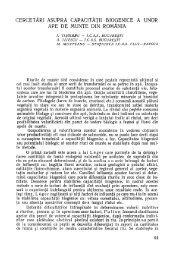
![studiu privind conditiilb] de vegetatie ale ... - EdituraSilvica.ro](https://img.yumpu.com/50877313/1/175x260/studiu-privind-conditiilb-de-vegetatie-ale-editurasilvicaro.jpg?quality=85)

